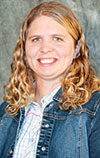During their first and third trimesters, cows were fed the same positive energy diet.

“Muscle development peaks in mid-gestation, and fat development is just getting started in mid-gestation, so we really thought that window of time was going to be the most interesting opportunity to alter eventual carcass composition of the offspring,” Blair says.
The 3- and 4-year-old cows came from a common herd at SDSU’s Antelope Range and Livestock Field Station in northwestern South Dakota and Cottonwood Range and Livestock Field Station in western South Dakota.
In the USDA- and South Dakota Beef Industry Council-funded research, Blair wanted to feed a diet that would maintain a body condition score of 5 through mid-gestation in the control group. In the restricted-energy diet group, they were on target to lose a body condition score.
To determine that, they took body condition scores, bodyweights and ultrasounded them for carcass, backfat and ribeye to see if they were losing weight, body condition or muscle and fat in the negative energy group or maintaining or gaining in the positive energy status.
For their negative energy group, Blair did not want to cut their energy needs to the extreme. Instead, she wanted to replicate something that may actually happen in a commercial operation. They cut their energy to 80 percent in the negative energy group.
“We wanted to do something that we thought maybe normally happened in this part of the world during gestation,” Blair says.
During mid-gestation in South Dakota and surrounding states, cows are many times grazing cornstalks or lower-quality forage.
Once finished with the second trimester, the negative group was fed the same as the positive energy group. All cows were calved out on the same diets and pastures through weaning.
After weaning, calves were transported to SDSU’s feedlot on campus in Brookings, South Dakota. They split the calves into steers and heifers to feed them. They harvested the calves at Tyson in Dakota City, Nebraska, and took carcass data.
While Blair says there were not a ton of significantly different results, what was different was interesting.
Looking at feedlot performance, calves from cows in the positive energy group weighed more at receiving up to 57 days in the feedlot. After that, both groups were even.
Looking at carcass performance, they did not see a difference in hot carcass weight, ribeye area, marbling score and shear force. In offspring from cows fed the negative energy diet, those carcasses tended to have improvement in 12th rib backfat and yield grade.
The significant difference between the groups came in the M ratio. That is the marbling ratio, which is the ratio of marbling to backfat. Those in the negative energy group put down more marbling in relation to backfat.
“It’s just changing up how they deposit fat, which is pretty interesting – as a producer and meat scientist, more marbling is great and less backfat is great,” she says.
Blair says the research results coincide with theories about fetal programming, where those calves in the negative energy group were setting themselves up to be a little more thrifty.
During the research, they also took a subset of 24 calves in the feedlot and put them through a health challenge. They injected them with harmless albumen, or egg protein, to see what kind of immune response they would have. Those fed the positive energy diet responded better than those in the negative group.
“It fits with some other data that has also shown being in better condition or having more available nutrients in utero actually produces a healthier animal, which makes sense,” she says.
The energy research wrapped up in 2014. Now, Blair and other SDSU researchers are using SDBIC money to research protein intake during the second trimester.
In the protein study, they fed 108 cows at the Cottonwood Range and Livestock Field Station either a control diet that met protein requirements or a negative protein diet. In the third trimester, they took those groups and fed them the opposite.
In the end, they had four groups – control throughout, restricted throughout, control then restricted and restricted then control.
The calves were born at the research station and were fed the same throughout the feedlot stage. These calves were fed at the University of Nebraska’s North Central Research and Extension Center.
At harvest, they took samples to evaluate composition, fat, muscle, bone ash, color, tenderness and crude fat percentages in the meat.
They also did a muscle biopsy on 12 calves when they were born and again right before harvest. The researchers wanted to look at gene expression in those biopsies.
“What we wanted to do was take muscle biopsies and figure out what’s being changed in gene expression when we alter protein during gestation. We wanted to see at harvest how much of that was maintained,” Blair says.
Unfortunately, they are buried under a massive amount of data. Research results will likely be presented late this year. ![]()
Wendy Sweeter is a freelance writer based in South Dakota.
PHOTO: SDSU meat scientist Amanda Blair researched the effect of changing the energy of the cow’s diet mid-gestation and its effect on meat quality. Photo courtesy of SDSU.







